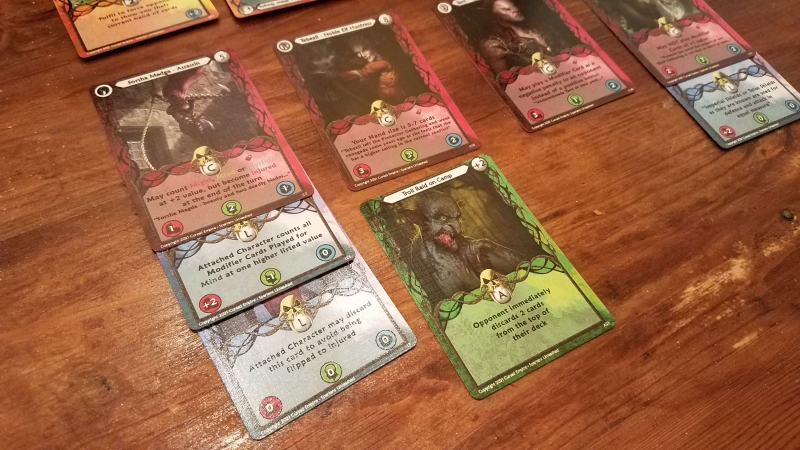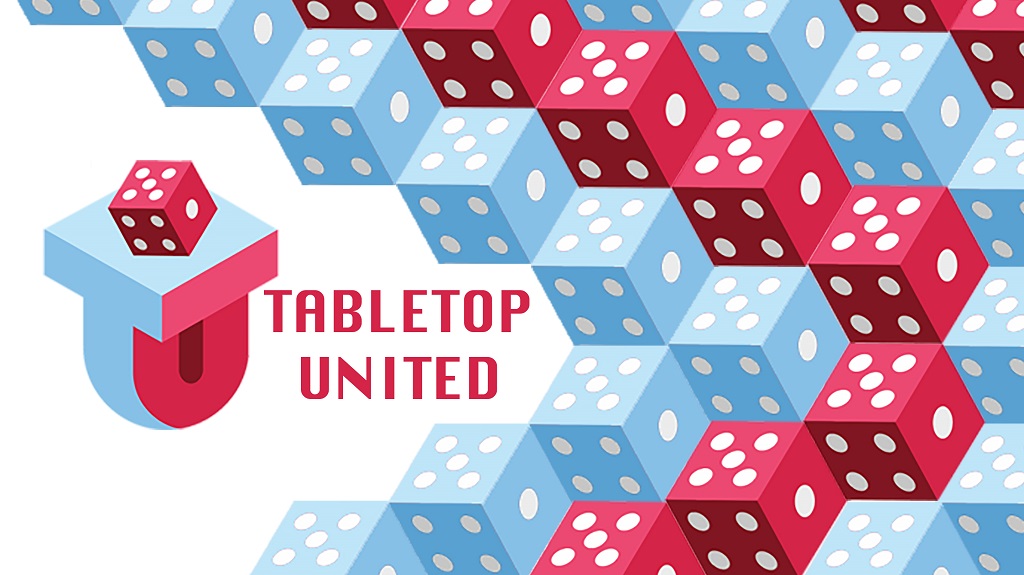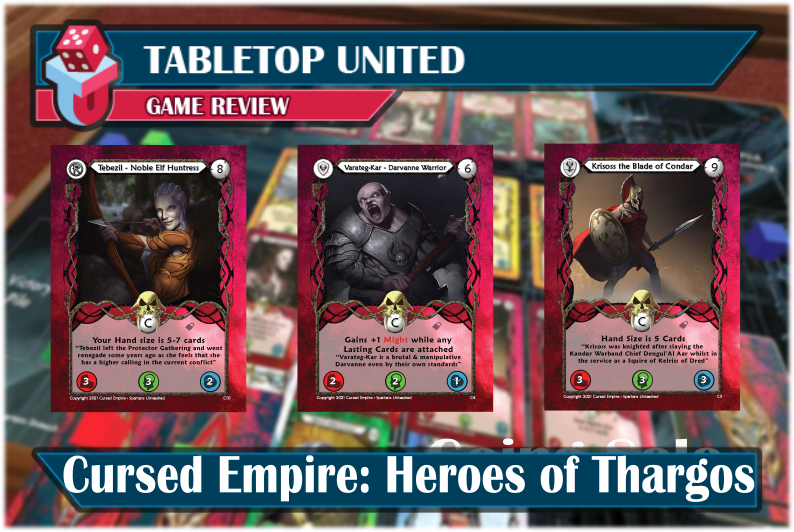Cursed Empire: Heroes of Thargos
Designer: Chris Loizou
Artist: Ryan Verhagen
Publisher: Spartans Unleashed
Year Published: Kickstarter 2021
No. of Players: 2+
Ages: 14+
Playing Time: 45 minutes per player
Main mechanic / Theme: Deck Construction, Combo making, Versus
Cursed Empire: Heroes of Thargos takes the traditional versus card game and adds a narrative element that is hard to replicate
Find more info on BoardGameGeek.com
Follow on Kickstarter
Disclaimer: The publisher provided a prototype copy of the game for this review.
Overview:
Cursed Empire is a card game where players compete against each other using unique heroes to accomplish various missions in order to gain renown. The player with the most victory points is the winner and their hero has risen in the world of Thargos.
Cursed Empire is much more than, though. Each game consists of four missions and as opponents finish their missions, you replace them with your own missions. This was a neat use of a catch-up mechanic as it helps level the playing field as the game progresses. In addition, you’ll choose four individual heroes that will fight to complete those missions throughout the game.
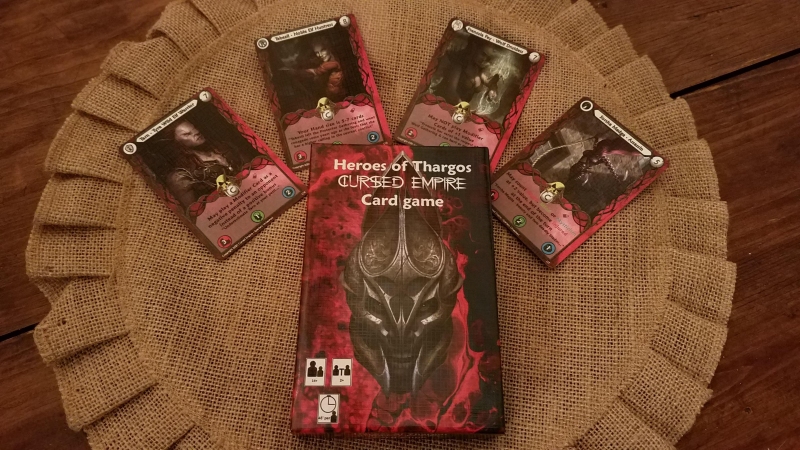
Gameplay and mechanics:
Although Cursed Empire is a “player versus player” game, it ends up being more than that. Choosing your four heroes is based on the character points on each card. However, increasing the power level also means that you’ll need more victory points in order to win based on the mission cards. Interestingly, the character cards are two-sided as the characters can get injured. When injured, flip the card over to show the adjusted stats from the injury.
There are not a lot of card types in Cursed Empire- Players will be using Character cards to win missions- those are called Mission cards. Blue border cards are called Lasting cards and finally, Action cards are the fourth type of card. All but the Character cards are shuffled for gameplay.
Character cards contain information needed to complete missions. Information such as Might, Mind, Mysticism, and any special rules can be found on both sides of the character cards.
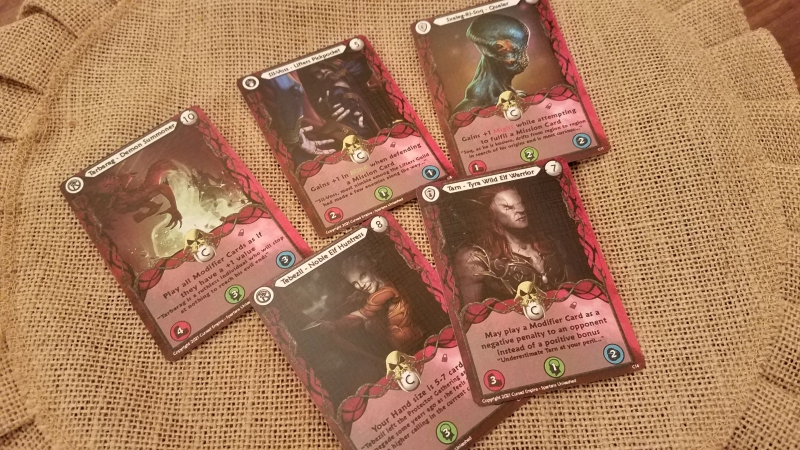
Mission cards are important to victory. When creating your Battle deck, your deck used to pull missions, actions, and Lasting cards from, you’ll add specific cards based on the Battle deck requirements. Players will get to add 4 copies of a single mission card plus any unique mission cards. The requirements of adding mission cards to a battle deck create interesting decisions and questions, such as, “do I add this card and leave these cards out?”. Players who love looking for combinations and ways to stack actions from one thing to the next will definitely enjoy this part of the game.
Missions have modifiers linked to each of the stats on the Character card. In order to win victory points, the Linked stats from your character cards to mission cards must be higher than the opposing character by the amount shown on the mission card. As an example, if the mission shows a +2 for the linked Might stat, after modifiers, you character MUST have 2 points higher in might than the opposing character. Having this comparison mechanic means that you’ll need to send the appropriate character on the appropriate mission. If a mission requires a greater difference to win, it would behoove the player to choose a character that has a higher value in that linked stat. To simplify, when resolving a conflict, add the mission stats to the defending character stack, and if equal or lower to the challenging player, the challenger wins.
One important aspect that I missed in gameplay was that any card can be played as a modifier. The cool feature of that is the attacker places a card face down in which the defender can counter by playing another card face down. As the attacker, you can make your opponent decide to burn cards in response if you are bluffing the win or have high confidence in the win. Either way, the bluffing element makes contesting the mission a much more "edge of your seat" proposition as you are never quite sure what the other player is considering. This makes the use of the Darkun Spider's ability much more potent when you can lay down additional cards after the defender has placed cards. The game of attrition is real since reducing your opponent's deck is a winning condition as well.
As players compete on the Mission track, the additional action and Lasting cards become important. When attempting to complete a mission, players take turns playing cards to see who will end up with a higher stat in the required area. Opposing players can in turn play cards as well. Lasting cards help Characters by adding new equipment, weapons, and even allies. Actions are one-time use cards and can be played as a quick buff to a stat. They won’t remain with the Characters as the Lasting cards do. Once the play of cards is over (It can’t go on indefinitely), both players add up the appropriate stat and see who has the highest, keeping in mind that the winner must win by the difference as shown on the mission card. The winner earns the appropriate number of victory points and adds the mission card to their score pile. The losing player then replaces that mission with one of their own. Play continues as both players attempt to complete missions using their Characters and any additional cards that buff and permanently help win those missions.
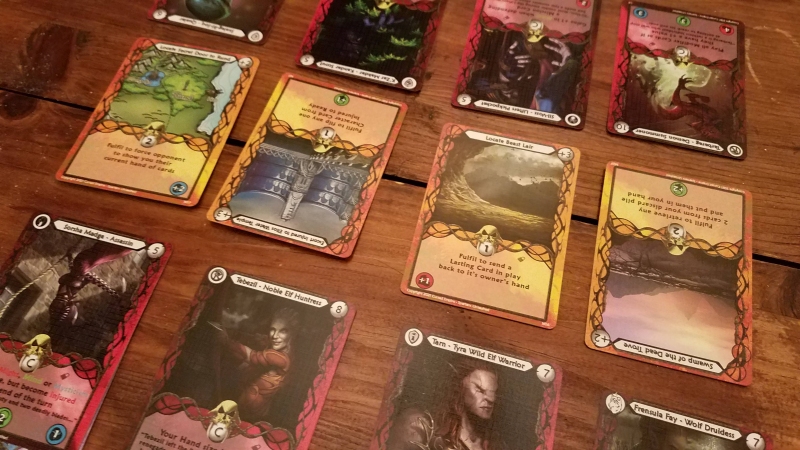
The premise behind Cursed Empire: Heroes of Thargos is fairly simple. Play cards to bump stats to complete missions. It may be cliche, but the game play is much more strategic. However, the interactions from the various cards, deck construction, and hand management is important. Deck construction rules are fairly straightforward. You can only have 60 cards in your deck plus your four character cards. You may only include four copies of a card unless it has a padlock on it which represents that card’s uniqueness- meaning you may only ever include one of that type in your deck. A player may also only have six cards in hand so you have to be ready to play the cards you have at the appropriate time. Being caught with too few cards will mean you can’t win that mission or you won’t be able to stop your opponent from taking it.
Theme, Artwork and Illustration, Graphic Design and Layout
The layout of information on cards is of utmost importance in a card game where the numbers on cards are very important. Without being able to see across the table what the sum of numbers is or what is adding to another card’s stats would mean that gameplay would come to a halt and players would spend more time searching for information than playing.
With that in mind, the location of and identification of information on the cards is obvious. Abilities and information written on the cards are easy to see. The layout is plausible and helps move the game along without causing confusion.
Since this is a fantasy game about specific characters going on missions and competing for “renown” in the world of Thargos, the expectations of the art should be well thought out in regard to the theme. The art isn’t overpowering. In this case, that’s a good thing so that you don’t get lost in it during the game. The art is well done, if a bit dark, making it hard to see. The prototype box is a little confusing as the main focus of the faces really doesn’t give you the feel of characters facing off on various missions. However, it is quite convincing that the current game is player VS player. In addition, the faces depicted really don’t look like heroes or champions. They look like demons or evil-spawned demons. The imagery goes against the title of the game itself in my opinion. Keeping an open mind that I was sent the prototype, the art definitely doesn’t detract from game play. If you enjoy fantasy art with magic, weapons, armor, and dangerous beasties, then the art is just fine. I’m hoping production value increases as the game picks up through manufacturing at some point. I’d love to see some of the artwork brightened up with better printing so I can see the details on some of the designs in the art.
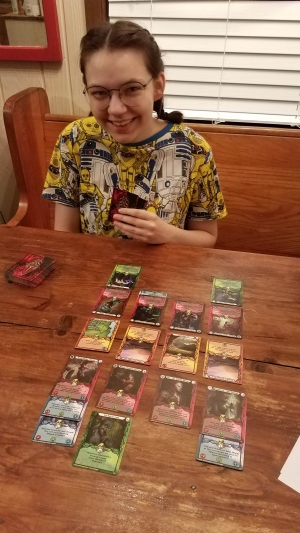
Inclusivity and accessibility
Tabletop United believes that diversity is a source of fun and happiness. Nurturing and celebrating our personal differences can lead to amazing gaming (and life) experiences.Therefore, TTU is putting renewed emphasis on inclusivity and accessibility by adding a section in each of our reviews written after April 2021. You’ll begin to see more reviews with this section as time goes on. The inclusivity and accessibility section will critique those issues and strengths of the subject in the review based upon the unique background of the reviewer. Each reviewer views the world through their own particular lens and has a wide and varied experience from which they will write and review from.

Cursed Empire: Heroes of Thargos is a fantasy game. Most of the characters and creatures within the artwork can be considered, at most, human or human-like. The sentient beings all look evil or mean, menacing, or scary. There appears to be a mix of both male and female Champions. Although the design and theme is carried through the entire card set, there are instances of figures that are less covered than others. The good news is that it’s not overwhelming and the artwork is not gratuitous. However, from certain perspectives, it could be considered objectification of the human body. In addition, since we are dealing with fantasy creatures, races are varied and all look strong, menacing, and dangerous. This is a card game. Gamers who find manipulating cards in hand and on the table will find the game difficult to play. Players who may not be able to see the cards and read the text will also find this game difficult to play. The game is dependent on identifying and being able to read the cards. If you are color-blind like I am, the designer has included letters that identify the type of card that each is- L for Lasting, A for Action, etc. I'm glad that designers and publishers are looking at ways to bring accessibility to more and more hobby and game enthusiasts.
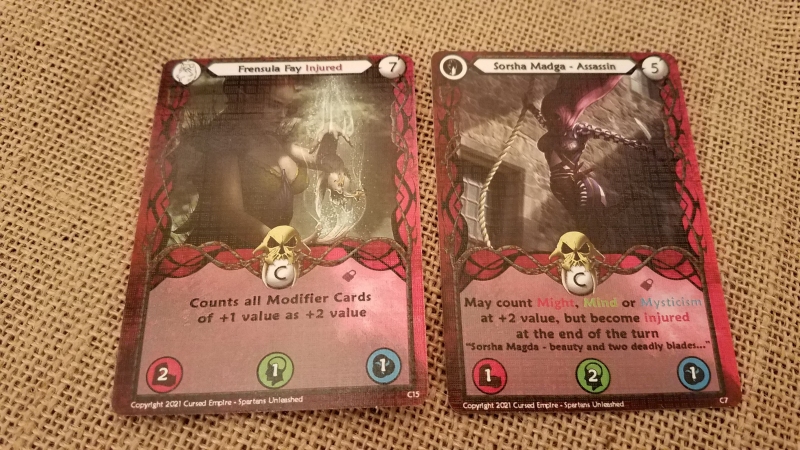
What worked:
The game flowed well. The order of play seemed well thought out and unlike a lot of 1 v 1 games where you are worried about losing health, Cursed Empire changes that up to focus on gaining points through missions instead of beating your opponent’s characters senselessly. It feels good to gain points instead of lose points. Furthermore, the game felt like you had a party of adventurers working to complete various missions. Having the ability to add different Champions adds to the game play. In addition, there is room to add more to the game through various items, characters, events, etc, and it feels good to know that there can be more to the game if the market bears it.
Final thoughts:
Cursed Empire: Heroes of Thargos will definitely endear itself to players who love designing decks for various states of game play. The joy of finding the perfect mix of cards which stack and buff the other cards in the deck leads perfectly to those players who dive into strategy- who enjoy puzzles and competing against others. This is a deep enough and strategic enough game that should keep players engaged with the core two decks through several game plays Cursed Empires has an upcoming story mode that also includes solo play. The story mode removes the mission track and adds more narrative element and teamwork to the mechanics. Also, you'll find that there is a large setting tied in to the card game in the form of an RPG.
